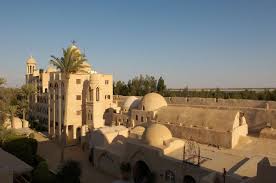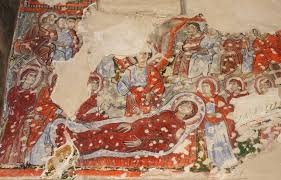
Dating back to the 6th century, the monastery of El Surian was built by the monks of Saint Beshoy Monastery who were opposed to Julianist doctrines that held the incorruptibility of Christ's body. By the end of the 8th century, the doctrinal problems ended, and the monastery was sold to rich Syrian merchants who donated it to a group of Syrian monks, thus it was named the Monastery of the Holy Virgin of the Syrian. Throughout the centuries, Egyptian monks substituted the Syrian and now the monastery belongs to the Egyptian Coptic Church. Like other buildings of the area, the monastery was damaged by the attacks of the Bedouins and restored several times. The monastery's walls measure almost 11 m in height with the entrance in an extreme of the north side. Built in the 9th century, the tower consists of four floors with a drawbridge in the second one. The bottom floor was used as a storeroom and it had a well. The library that once had a valuable collection of manuscripts (now scattered between the Vatican and the British Museum) was in the second floor. In the 3rd floor, there were dormitories for the monks and in the 4th, there was a chapel dedicated to the Archangel Michael. Within its compound, the monastery comprises: a water tower, the refectory, a special library, a museum, a number of cells for the monks, and 4 churches. Built by Moses Nisibis, the Chapel of the Forty-Nine Martyrs was dedicated to the forty-nine martyrs killed by the Bedouins in 444. The chapel has scenes of the Holy Virgin, Saint Mark Evangelist and Patriarch Athanasius. Among the 4 churches, are the church of Saint Honnos and Marutha (10th century) which is not now in use and the Church of Saint John the Little which is in ruins. Dating to the 11th century, the Church of the Lady Mary has a rectangular plan with a vaulted roof, a choir, and a sanctuary, all influenced by the Mesopotamian style. The skillfully-made wooden works in the doors and the iconstasis are very beautiful. The Church of The Holy Virgin (the 7th century) was built in a basilican plan. A domed court leads to the church that consists of a nave, a choir, and a sanctuary. The vaulted ceiling of the central nave is made of wood. On both the walls and the cupola, there are paintings of Abraham, Isaac, Jacob, the Ascension of Christ, the Virgin , the Twelve Apostles, Christ in his throne with moon on his right and the sun on his left, the Annunciation, and the Dormition of the Virgin among others. Made of ebony and ivory incrustations, the eleven-century door that separates the choir from the sanctuary is a very beautiful masterpiece of carpentry.
The Church of the Holy Virgin

The Church of the Holy Virgin dates back to the 7th century and it was built in a basilican plan. A domed court leads to the church that consists of a nave, a choir, and a sanctuary. The vaulted ceiling of the central nave is made of wood. On the walls, there are paintings of Abraham, Isaac, Jacob, the Ascension of Christ, the Virgin, the Twelve Apostles, Christ in his throne with moon on his right and the sun on his left, and the Annunciation. The eleven-century wooden door that separates the nave from the choir is considered a great piece of art, as it is made of ebony, with ivory inlaid, containing forty-two panels in seven registers that have images of patriarchs and saints. The altar in the squared sanctuary dates back to the 10th century. The sanctuary has stucco friezes with the influence of Samarra art.
